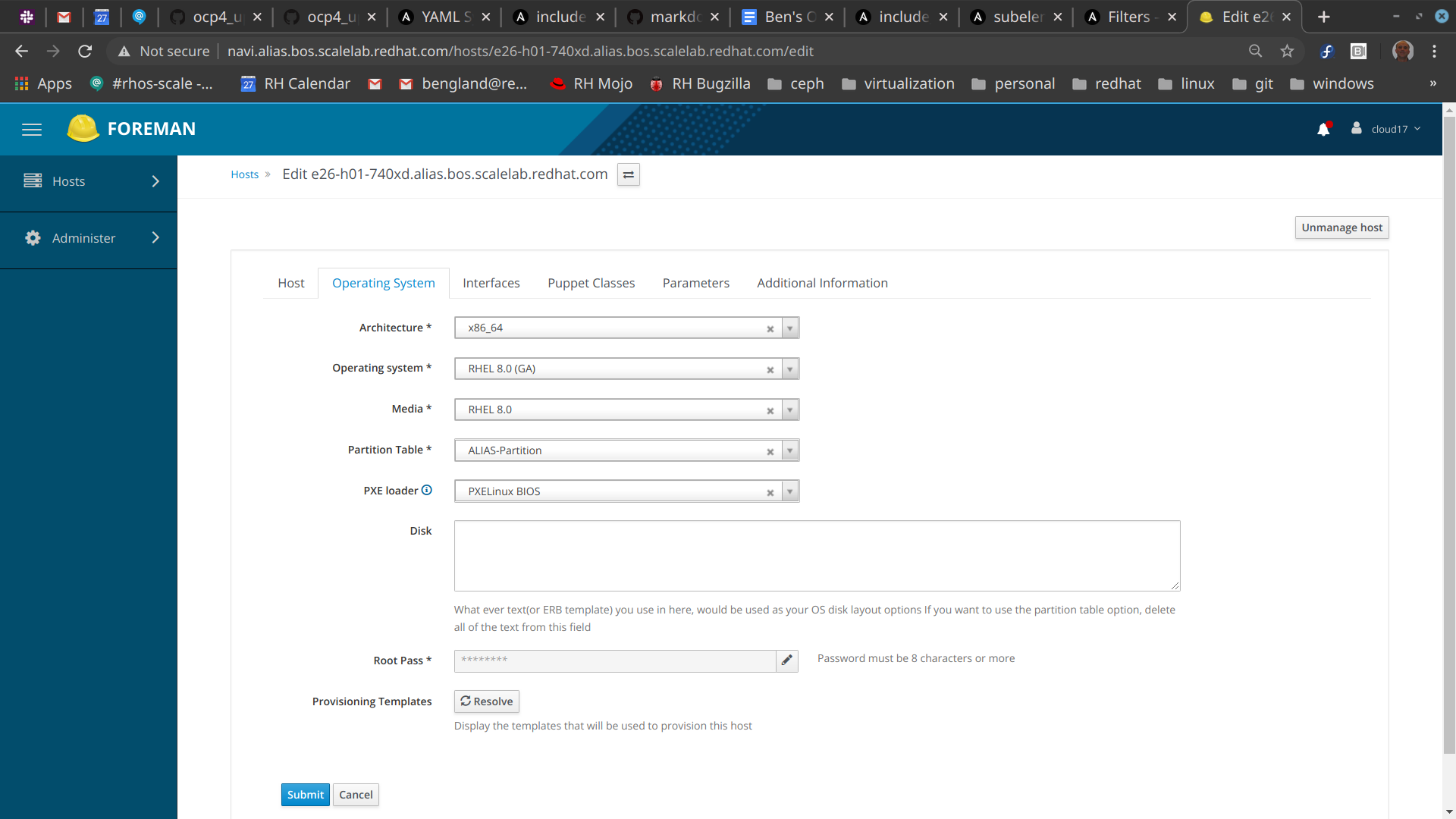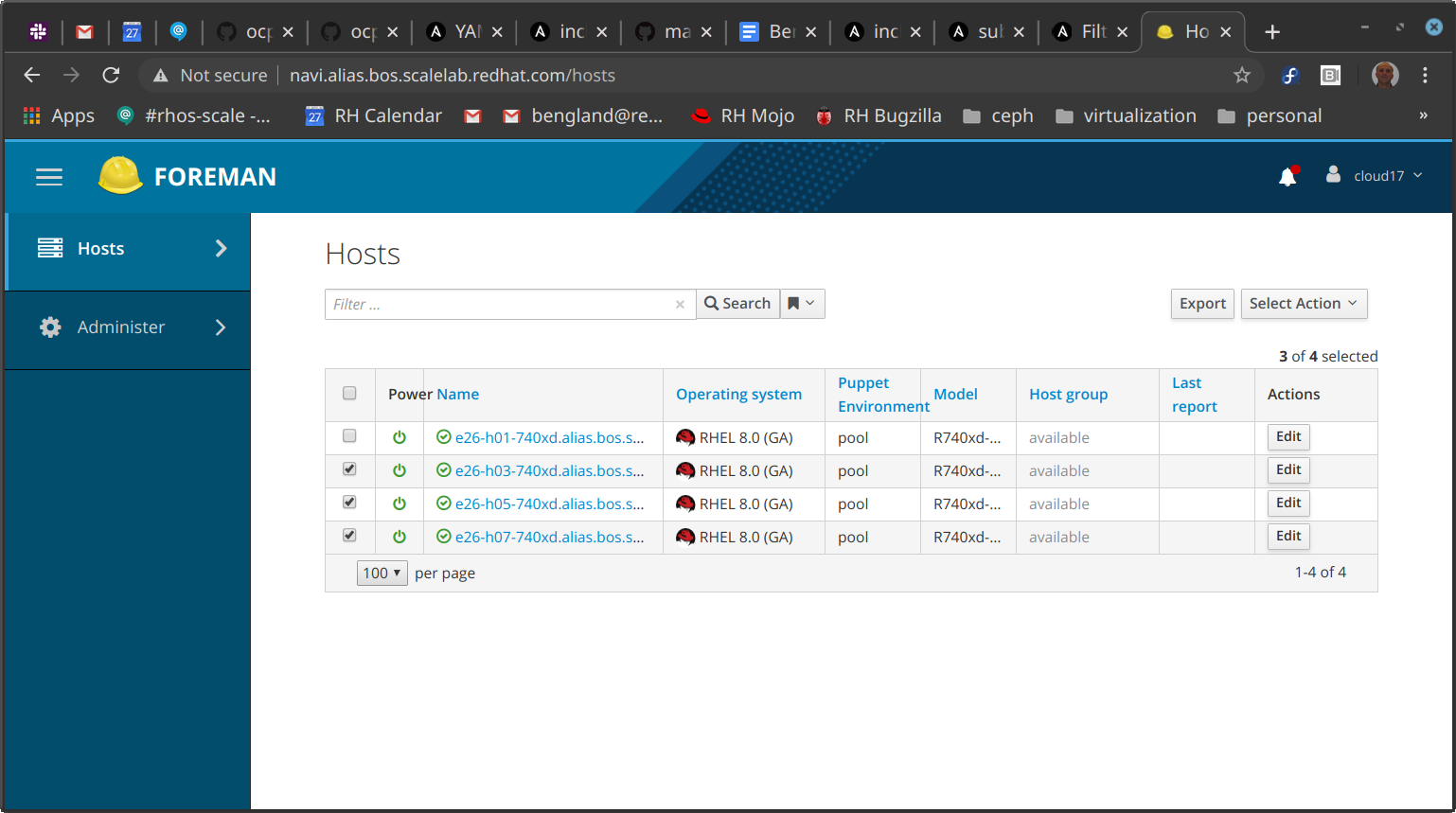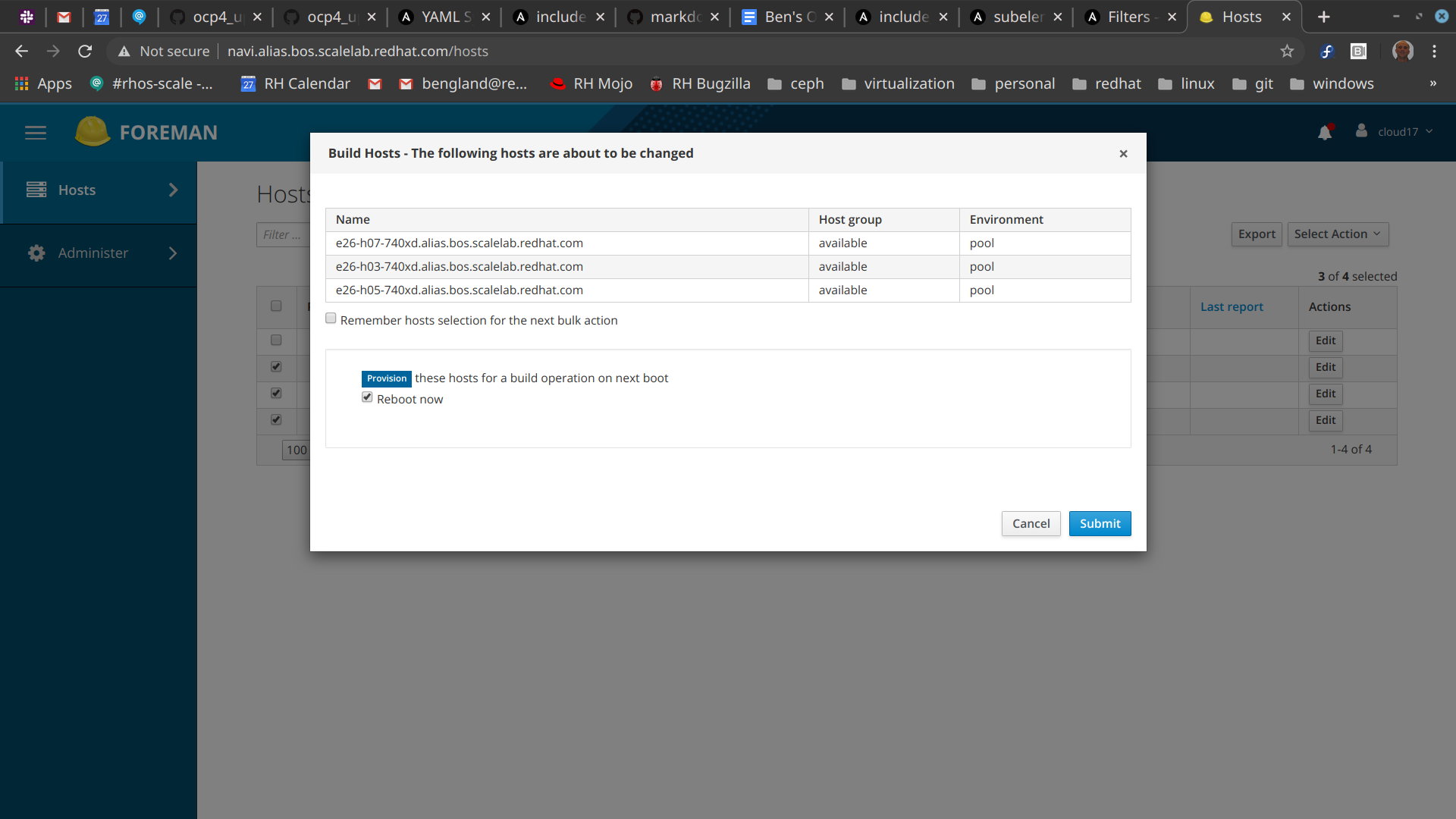** THIS REPO IS NOW OBSOLETE AND NO LONGER MAINTAINED**
Why: Sai Malleni's JetSki now can do the things that this repo used to do, and does it better and more in line with future direction of openshift-install (IPI).
This repo contains 2 ansible playbooks for implementing Dustin Black's method for doing OpenShift 4 UPI installation on bare metal machines. Dustin's document is at this link. For a link to openshift-install support for bare metal machines, see this documentation.
- supports only Alias and Scale Lab
- supports only baremetal at this time (no public clouds)
- public interface to outside world is assumed to be slow
- cluster must start out on RHEL8/Centos8 - RHEL7 not supported
- playbooks must run on Linux (Fedora 31, RHEL8 tested)
You can run it from a host totally outside your cluster, or you can run it from the "deployer" = provisioning host. If you do the latter, the playbook will be interrupted when it gets to the reboot, which is necessary as part of the upgrade of RHEL. That's ok, just login after the reboot and restart the playbook, it should skip that set of tasks and move on from there. It will discover that the block "upgrade to latest RHEL GA" has already been executed.
The first step happens when you get your lab reservation. At this time, we require that RHEL8/Centos8 be installed on your deployer, masters and workers - RHEL7 will not work. This change can be done with Foreman GUI in Alias, for example.
background: This is necessary so that we can automatically determine the network interface names and mac addresses for your openshift cluster nodes. In the future I hope to transition to using metadata from the labs such as this example.
Go into each host, use "Operating System" tab, fill it out like this:
Afterwards, you want your machines to look like this in Foreman:
You then rebuild them using the 'Select Action' button, you should get a dialog box like this one:
After the RHEL8 rebuild completes, you can then discover information about your cluster using ansible fact-gathering. To get started:
# dnf install -y git ansible
Once that's done, pull deploy playbooks and configure them:
# git clone https://github.com/bengland2/ocp4_upi_baremetal
# cd ocp4_upi_baremetal
You must ensure that you have password-less ssh access to all the machines in your cluster inventory,
so that password-less ssh is possible (ansible depends on this).
- You may need to create a public-private key pair if you haven't already done this, with ssh-keygen.
- If necessary, clear out ~/.ssh/known_hosts entries for previous incarnations of these hosts.
Construct an input inventory file to define 3 host groups:
- deployer - only one host in this group, it provides services to the entire cluster such as DHCP, HTTP, PXE, DNS, and NTP.
- masters - usually 3 of them, this provides OpenShift Kubernetes management infrastructure. If there are no workers, apps can be run on them too
- workers - can be 0 to ... well we don't know yet. Usually apps and OCS run here, as well as workload generators.
For example, here's inventory.yml.sample:
[deployer]
e26-h01-740xd.alias.bos.scalelab.redhat.com machine_type="740xd"
[masters]
e26-h03-740xd.alias.bos.scalelab.redhat.com machine_type="740xd"
e26-h05-740xd.alias.bos.scalelab.redhat.com machine_type="740xd"
e26-h07-740xd.alias.bos.scalelab.redhat.com machine_type="740xd"
[workers]
e26-h09-740xd.alias.bos.scalelab.redhat.com machine_type="620"
The machine type has to be recognizable as one of the types in lab_metadata.yml. This metadata file defines properties of each machine type:
- deploy_intf - high-speed NIC port used to deploy OpenShift
- public_intf - low-speed NIC port to outside world, disabled on OpenShift machines
- data_intf - 2nd high-speed NIC port for use by OpenShift apps
- disabled_intfs - which network interfaces should be disabled on OpenShift machines
- badfish_boot_order - director record to use for this type of machine
This allows you to avoid defining the variables needed by the playbook for each machine or machine type.
Now run the first playbook to install public key, register nodes with subscription manager and install python3 in such a way that ansible modules can function correctly. At present this playbook allows use of subscription-manager to get most up-to-date RHEL8 repos. You have to enter a subscription manager username and password, once, with the password not echoed and not logged.
ansible-playbook --ssh-common-args '-o StrictHostKeyChecking=no' \
-i inventory.yml -e ansible_ssh_pass=TakeAWildGuess install_public_key.yml
You then run the discover_macs.yml playbook one time, to generate an inventory file with mac addresses defined for all machines.
ansible-playbook -vv -i inventory.yml discover_macs.yaml
This should output a file named ~/inventory_with_macs.yml by default - it will look the same as your previous inventory but with per-host deploy_mac variable added to each record. From now on, you use this as your inventory file, not the preceding one.
Then define your cluster parameters by doing:
cd group_vars
cp all.yml.sample all.yml
<edit all.yml>
cd ..
Now you prepare your deployer host with:
ansible-playbook -i ~/inventory_with_macs.yml ocp4_upi_baremetal.yml
This playbook can be used whenever a re-install of the deployer host is needed, regardless of what state the masters and workers are in, because the mac addresses never change.
Dustin's document describes what the playbook should be doing. This will take a long while, and may involve the reboot of the deployer host and download of RHCOS and openshift. When it finishes, you will have a deployer host that is set up to install masters and workers. We do not actually install the masters and workers in this playbook.
To get ready for openshift deployment, login to the deployer host first.
To start master and worker installation, from the deployer host use badfish.py for Dell machines. It applies commands to a list of hosts in a file. At present, it does not support SuperMicro machines, but should work with most Dell machines (that have Redfish API).
Now you must set up boot order and enable PXE on all openshift nodes.
alias badfish
badfish --host-list ~/all_openshift.list -t director
<wait until hosts are done rebooting, this may take minutes>
badfish --host-list ~/all_openshift.list --check-boot
badfish --host-list ~/all_openshift.list --pxe
Note: to be a good lab citizen, you must reset the machines from "-t director" to "-t foreman" mode This is one of the deficiencies of this procedure - ideally it should not allow a machine to PXE boot more than once.
First we must bring up the masters and establish an openshift cluster:
badfish --host-list ~/masters.list --power-cycle
To monitor installation from OpenShift perspective, use this command sequence:
cd ~/ignition
openshift-install wait-for bootstrap-complete
when this shows that OpenShift cluster has formed, then shut off the bootstrap with
virsh destroy ocp4-upi-bootstrap
Now we can start installing the workers - this can slightly overlap the masters, since initial phase of worker install does not involve openshift at all, just CoreOS install.
badfish --host-list ~/workers.list --power-cycle
If all goes well, then the CoreOS and ignition files will be pulled onto all of these machines and they should reboot and join the OpenShift cluster.
For SuperMicros in the scale lab, you need to do the following:
for node in `cat ~/all_openshift.list`; do ipmitool -I lanplus -U quads -P "$QUADS_TICKET" -H $node chassis bootdev pxe; done
for node in `cat ~/masters.list`; do ipmitool -I lanplus -U quads -P "$QUADS_TICKET" -H $node chassis power reset; done
and later on when the masters have formed a cluster:
for node in `cat ~/workers.list`; do ipmitool -I lanplus -U quads -P "$QUADS_TICKET" -H $node chassis power reset; done
For any tasks which have to be done to the openshift cluster after it is created, you can run this playbook from your deployer host:
cd
ansible-playbook --ssh-common-args '-o StrictHostKeyChecking=no' \
-i post_install_inventory.yml post_install.yml
This has to be run there because it uses hostnames like "master-0"
that aren't defined outside of the cluster.
It is using the DNS server (dnsmasq) in the deployer host.
At present this playbook:
- makes the deployer host a time server for the OpenShift hosts using the deploy_intf network. Ceph (OpenShift Container Storage) depends on time synchronization.
- approves CSRs which workers need. Without this step, workers won't join the OpenShift cluster.
You may have to run this more than once if not all workers have reached the right stage where their CSRs have been submitted to the OpenShift Cluster. That's ok, the procedure is idempotent so it can be run as many times as necessary.
To access the openshift console from your laptop:
# ssh -N -D 9090 kni@e24-h19-740xd -f
# /usr/bin/google-chrome --user-data-dir="$HOME/proxy-profile" \
--proxy-server="socks5://localhost:9090"
This brings up a browser window that will be able to use the DNS server on the deployer host, and you can now enter the usual URL, such as:
https://console-openshift-console.apps.test.myocp4.com
When you are done with the cluster, or if you want to re-install from scratch, use the next command to revert the boot order to the original state that the QUADS labs and Foreman expect.
badfish --host-list all_openshift.list -t foreman
<wait until hosts done rebooting>
badfish --host-list all_openshift.list --check-boot
Keep checking boot order every 5 min until you see "Current boot order is set to: foreman" or at least that first interface in boot order is the foreman interface.
To get a good log of the run so that others can see what happened, try adding this to end of your playbook command:
ansible-playbook ... 2>&1 | tee r.log
This playbook is designed to minimize repeated tasks by checking to see if a group of tasks are necessary or not - this feature is particularly nice when running the playbook from outside red hat (i.e. on your laptop from home). This is somewhat problematic if the configuration changes and you re-run the playbook. Look for tasks named "see if…" and you can force the playbook to re-run those steps in most cases by just deleting some configuration file from the deployer host. If needed, we can add a "force" option to make it skip this optimization later.
The slowest step in the installation procedure is download of RHCOS. If you have to repetitively download the entire RHCOS directory (pointed to by rhcos_url in group_vars/all.yml), because of multiple sites or lab incarnations , then download to a local directory and then get it from there. The rest of the playbook takes about 20 min to run, even from a remote laptop.
To see whether masters and workers are pulling files from httpd service on the deployer host:
tail -f /var/log/httpd/\*log
To see whether DHCP and TFTP requests are being received by the deployer host:
journalctl -f
To see whether bootstrap node is ready for masters, do the next command -- you want to see it trying to talk to the masters to establish a cluster quorum, it should be getting either node unreachable, connection refused, or invalid cert (master is from previous incarnation of cluster):
ssh core@bootstrap journalctl -f
To see whether CoreOS is installing, watch the console for a master node or worker node. Normally, the PXE boot installs CoreOS image using the kernel boot line at the top, and then the system reboots to CoreOS on disk. It next pulls ignition files using HTTP GETs logged on console. When that succeeds, then it reboots again, and at this point the node knows enough to try to join the cluster. Monitor its progress there with.
oc get nodes
Finally, when the cluster quorum is formed, see if it is making progress using:
oc get co
which shows operators being installed and brought online.


